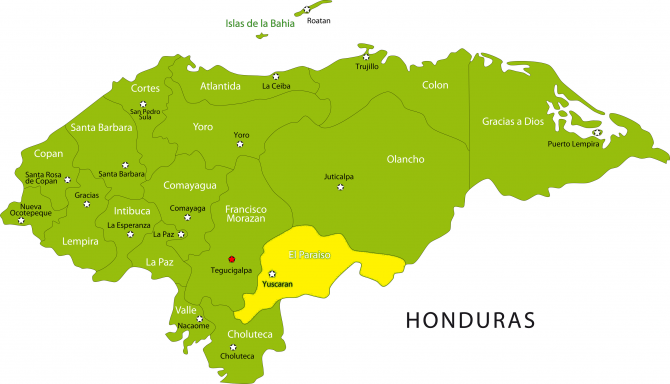El Retiro, Morocelí, Honduras
![]()
![]()
![]()
![]()
![]()
![]()
![]() Click on Programs to learn more about their work in this community
Click on Programs to learn more about their work in this community
General Information
| Population* | 440 |
| Number of homes | 120 |
| Avg # of people per home | 3.6 |
| % of children under 12 | Approx 23% |
| Primary Occupations | Agriculture - coffee, corn, beans, plantains |
| Water System | Yes |
| Rural Bank | Yes |
| % of Houses with Latrines | 30% |
| Electricity | No |
| Corresponding Health Center and Distance | CESAR - Buena Vista, 30 minutes walking |
| Common Illnesses | Respoiratory infections, flu |
| School Access and Distance | Kinder - 6th grade, in community |
| Municipality | Morocelí |
| Department | El Paraíso |
| Distance from compounds | 1 hour, 30 min |
* Population does not reflect how many patients will be seen on medical
brigades as many people from surrounding communities come seeking
Medical Brigades medical attention.
Top Three Needs Expressed
The top three needs expressed by the key community members are the construction of latrines, the construction of concrete floors, and the improvement of the roads into the community.


El Retiro is located near the municipality of Moroceli. It is about 30-45 minutes up the mountain from the town center of the municipality.
El Retiro’s educational system includes kindergarten and primary schools until 6th grade. There are 59 students total, and approximately 95% of the community knows how to read and write. If students wish to continue on past 6th grade, they must travel to the municipality of Morocelí, which can take 2-3 hours walking. Because of the far distance and financial strain it puts on families, many students do not continue past 6th grade.
This community has a water project that was constructed by Global Brigades in 2013. The system is currently functioniong well and brings water to all of the homes in the community. There is a water council of 7 members that is active and helps maintain the system.
El Retiro does not have a Health Center in the community. The nearest health center is in Buena Vista, which is located about 30 minutes walking distance, and the nurse is Jacqueline Suazo. There is a committee of 3 health monitors (“monitores de salud”) that have been trained by World Vision, and whose main role is to help oversee the weight and health of children in the community. Dental care is not available in or near the community.
The most common illnesses seen by community members are respiratory problems (bronchitis, colds, asthma, flu) and hypertension. Approximately 55% of the community has functioning latrines, eco-stoves, concrete floors, and pilas (water storage units).
The average family income per month is estimated to be 750 Lempiras, which is approximately L150 (US $7) per person. The majority of homes are made of adobe. The main form of employment in El Retiro is agriculture on owned land, and the main products that are cultivated are coffee, corn, beans, plantains, oranges, and other fruits.
El Retiro currently has a caja rural with 13 members. To this point the caja has worked mostly to support the Public Health projects. Volumes of savings and other loans are low, but we hope to increase participation in the community bank throughout 2016 as we bring brigaders to consult and teach in the community.
The community’s leaders are organized and would involve themselves in further projects. This community also has a good working relationship with Vision Mundial (World Vision) that can help them collaborate on additonal projects when funding is needed.
Check back soon for more pictures of this community!
Source of information: Key informant interview, Health Center statistics
Date of interview: 30 November 2012
1The accepted regulation frequency for chlorinating water is every 4 days.
2CESAMO and CESAR are terms used for types of health centers. CESAMOs are larger, more comprehensive facilities that usually have a physician on staff at all times and occasionally a dentist. CESARs are more remote, less equipped facilities, usually with 1-2 nurses on staff.
3According to Red Solidaria and World Food Programme in Honduras, the average family is approximated at 5 people per household, the poverty line is L930 (US$49.23) per person per month, and the extreme poverty line is L617 (US$32.66) per person per month.